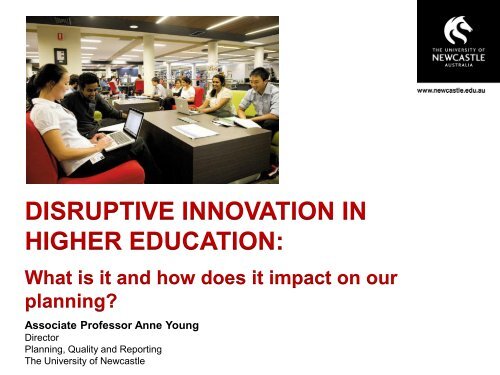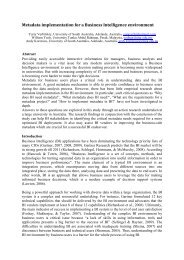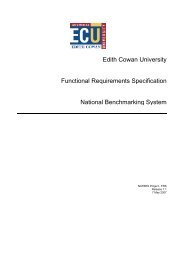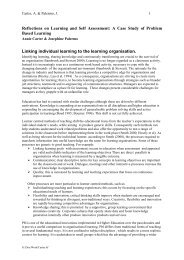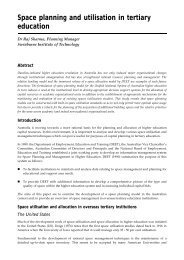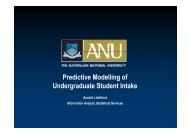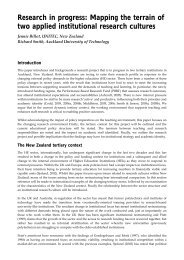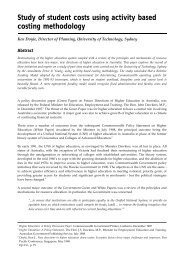DISRUPTIVE INNOVATION IN HIGHER EDUCATION: - aair
DISRUPTIVE INNOVATION IN HIGHER EDUCATION: - aair
DISRUPTIVE INNOVATION IN HIGHER EDUCATION: - aair
You also want an ePaper? Increase the reach of your titles
YUMPU automatically turns print PDFs into web optimized ePapers that Google loves.
<strong>DISRUPTIVE</strong> <strong><strong>IN</strong>NOVATION</strong> <strong>IN</strong><br />
<strong>HIGHER</strong> <strong>EDUCATION</strong>:<br />
What is it and how does it impact on our<br />
planning<br />
Associate Professor Anne Young<br />
Director<br />
Planning, Quality and Reporting<br />
The University of Newcastle
Disruptive innovation<br />
“is an innovation that makes a complicated<br />
and expensive product simpler and cheaper<br />
and thereby attracts a new set of customers.”<br />
Clayton Christensen<br />
Harvard Business School<br />
Forum for the Future of Higher Education, 2008<br />
2
Example of disruptive innovation<br />
3
Sustaining versus disruptive technologies<br />
Technology transforms:<br />
• human resources<br />
• capital<br />
• materials<br />
• information<br />
Products and services<br />
of greater value<br />
Sustaining technologies generally improve the performance of<br />
established products, that is valued by mainstream customers in<br />
major markets.<br />
Disruptive technologies usually have worse product performance initially<br />
but have features that (generally new) customers value. They are often<br />
cheaper, simpler, smaller or more convenient to use.<br />
Ref: The Innovator‟s Dilemma, Clayton M. Christensen, 1997<br />
4
PRODUCT PERFORMANCE<br />
The impact of Sustaining and Disruptive<br />
Technological Change<br />
High end<br />
performance<br />
Low end<br />
performance<br />
TIME<br />
Ref: The Innovator‟s Dilemma, Clayton M. Christensen, 1997<br />
5
PRODUCT PERFORMANCE<br />
The impact of Sustaining and Disruptive<br />
Technological Change<br />
High end<br />
performance<br />
Disruptive<br />
technological<br />
innovation<br />
Low end<br />
performance<br />
TIME<br />
Ref: The Innovator‟s Dilemma, Clayton M. Christensen, 1997<br />
6
Why companies fail to compete<br />
May be due to bureaucracy, arrogance, tired executive,<br />
poor planning, short-term investment horizons, inadequate<br />
skills and resources, or even bad luck<br />
BUT<br />
well managed companies can also lose market dominance<br />
by not investing in disruptive technologies. They may have<br />
concerns about:<br />
lower margins rather than greater profits, „insignificant‟<br />
markets, the new products may not appeal to the most<br />
profitable customers<br />
Ref: The Innovator‟s Dilemma, Clayton M. Christensen, 1997<br />
7
How does this relate to Higher Education<br />
„Disruptive innovation‟ is now evident in the way<br />
information is stored, organised, transmitted and<br />
retrieved. Examples include:<br />
• Online and blended learning<br />
• Mobile and Cloud computing<br />
• Social networking<br />
• MOOCs (massive open online courses)<br />
“In the near future, “internet appliances” may become disruptive<br />
technologies to suppliers of personal computer hardware and<br />
software” (The Innovator‟s Dilemma, Clayton M. Christensen, 1997)<br />
8
The media tells the story<br />
9
Coursera (>1.7M students by Oct 2012)<br />
10
Academic Earth (free online video lectures)<br />
11
iTunes U (manage, distribute and control access to digital content)<br />
12
Sample of the current literature<br />
13
The Disruption of Harvard Business School<br />
• Costs about $250,000 to get a Harvard MBA<br />
• Concerns about moving up the quality chain and losing<br />
touch with the mainstream customers<br />
• Many companies cannot afford to hire Harvard MBAs<br />
• Corporations now setting up their own universities<br />
• „Harvard advantage‟ is networking, connections, brand<br />
• Is there a need for thinking outside the current<br />
organisational structure in order to innovate<br />
• Migrate away from „teachers‟ to hardware and software<br />
programs that customise students‟ learning experiences<br />
Ref: Disruptive Innovation and Catalytic Change in Higher Education<br />
Clayton M. Christensen, Forum for the Future of Higher Education, 2008<br />
14
What is the impact for planners<br />
Where and how do we recruit students<br />
What type of teaching and learning facilities (physical and<br />
virtual) are most appropriate<br />
How many academic staff are needed and what should<br />
their skill set be<br />
When does attending class add value<br />
What resources do students need and how do we match<br />
expectations (“anywhere, anytime and on any device”) <br />
How do we become more strategic in our planning<br />
15
How to respond to the challenge<br />
• Accept that fundamental change is coming to<br />
higher education<br />
• Realise that online learning will allow more<br />
students to study with high quality and<br />
affordable cost<br />
• Acknowledge that many students will continue<br />
to place value on the campus experience<br />
• Strategic investments in staff and physical<br />
facilities will continue to have value<br />
• Adopting online learning technologies will offer<br />
the best of both worlds<br />
16
Surviving and thriving<br />
• Institutions that cling too long to the old<br />
model are unlikely to survive<br />
• Those that innovate quickly have a bright<br />
future<br />
• Innovation is not a defensive reaction but<br />
a strategy for success<br />
• What is your institution‟s „DNA‟ and can it<br />
be re-engineered<br />
• How can you focus on your institution‟s<br />
unique strengths to raise quality, lower<br />
costs and add value<br />
17
In summary:<br />
How are creativity and<br />
innovation integrated into<br />
YOUR planning processes<br />
Associate Professor Anne Young<br />
Director<br />
Planning, Quality and Reporting<br />
University of Newcastle, Australia<br />
anne.young@newcastle.edu.au


